Bicycle Accident Prevention
Bicycle accident prevention while road riding should be your prime focus. Nothing can ruin a dream bicycle tour more than even a minor bike accident with a motor vehicle. Unfortunately, a bicyclist is at a disadvantage in any encounter with a large, fast, sometimes unpredictable motor vehicle.
Fortunately though, bicycle accident prevention is the responsibility of a smart, prepared, and skilled rider.
- Pay attention with your eyes and ears to everything around you.
- Don’t have earphones blaring music in your ears.
- Make eye contact with motorists that may impact your riding path.
- Ride with your hands ready to brake in an emergency.
- Be ready to exit the road and/or react quickly.
- Act assertively and claim your part of the roadway.
It takes two to have a collision. One or both persons must not be paying attention, disregarding safety considerations, and/or not realizing the other’s intention. Therefore, most and maybe all accidents are avoidable if you realize the situation and react accordingly.
Right Turn Hook
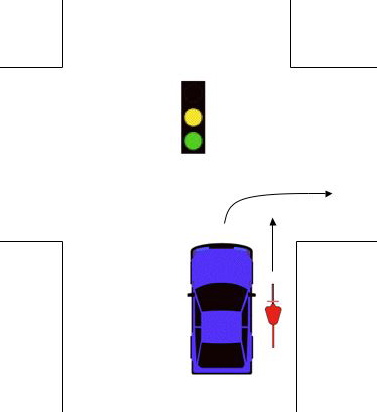
Situation:
A bicyclist is riding near the curb with traffic and approach a cross street. The bike and the car may or may not be stopped at the intersection. The bicyclist rides through the intersection and the car turns right. A car bicycle collision occurs.
Precautions:
To assure bicycle accident prevention you must stay far enough from the curb that the motorist doesn’t assume that you are going to turn. If you are in a turning lane and plan on going through the intersection, then move out of the turning lane. In fact if you are stopped at the intersection, you can get behind the car and act as another car and move with the traffic. Stay out of the motorist’s blind spot; make sure that you are in front or slightly ahead of the motor vehicle and look to your side and verify eye contact.
Right Cross
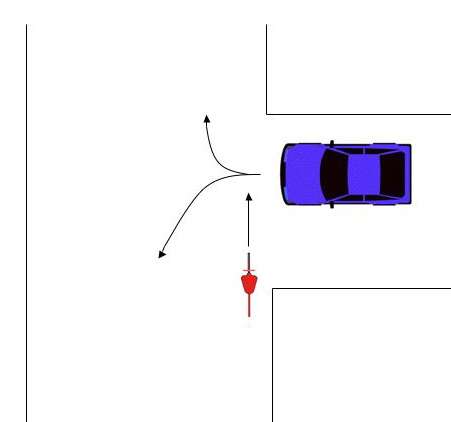
Situation:
The right cross is a common car bicycle collision. A bicyclist rides down the road close to the curb and a car pulls out from a side road or parking area. The car hits the bike broadside or bicyclist hits the car. Either case a bike accident occurs.
Precautions:
Stay far enough from the curb that the motorist sees you but not too far that you interfere with the lane traffic. Stay visible to the crossing motor vehicle, but do not jerk into the lane traffic. Slow down near the side road and have your hands ready to brake. It is your responsibility here for bicycle accident prevention.
Red Light Stop
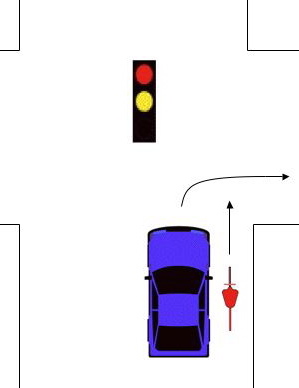
Situation:
A bicyclist stops at a red light in the blind spot of the alongside motor vehicle. The bike goes through the intersection with a green light and the motor vehicle turns right into its path.
Precautions:
Stay out of the blind spot of the motorist. Move forward so the motorist can see you and maintain eye contract with the driver as you move forward. If the motorist looks toward the turn, then the motor vehicle probably will turn. Or you can move directly behind the motor vehicle as if you are a car. Move forward with the traffic and gradually resume your riding location near the curb.
Left Cross
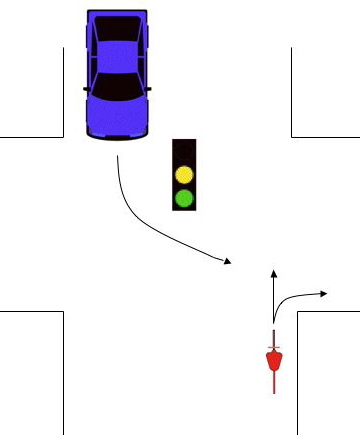
Situation:
An oncoming motor vehicle stops at a light or approaches an intersection and turns into the path of the bicyclist. Some motorist believe they always have the right-of-way when encountering a bicyclist.
Precautions:
When you approach this situation, move slightly away from the curb into the traffic lane so an oncoming motorist doesn’t think you are going to turn. Your hands need to be on the brake levers ready to react. If the motorist doesn’t signal a turn, the motor vehicle will normally slow down before turning. Keep eye contract with the motorist.
Wrong Way Head On
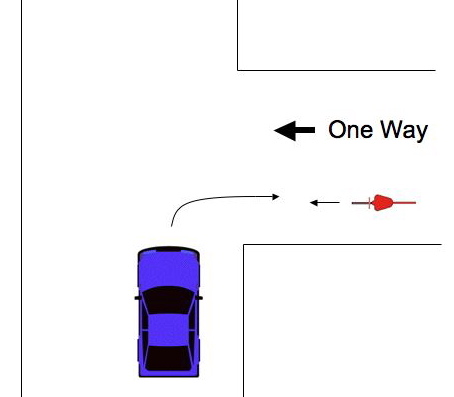
Situation:
A bicyclist is traveling down a one-way street. A motor vehicle comes from a cross street and turns down the wrong way of a one-way street.
Precautions:
Stay out of the blind spot of the motorist. Move forward so the motorist can see you and maintain eye contract with the driver as you move forward. If the motorist looks toward the turn, then the motor vehicle probably will turn. Or you can move directly behind the motor vehicle as if you are a car. Move forward with the traffic and gradually resume your riding location near the curb.
Left Cross

Situation:
An oncoming motor vehicle stops at a light or approaches an intersection and turns into the path of the bicyclist. Some motorist believe they always have the right-of-way when encountering a bicyclist.
Precautions:
When you approach this situation, move slightly away from the curb into the traffic lane so an oncoming motorist doesn’t think you are going to turn. Your hands need to be on the brake levers ready to react. If the motorist doesn’t signal a turn, the motor vehicle will normally slow down before turning. Keep eye contract with the motorist.
Wrong Way Head On

Situation:
A bicyclist is traveling down a one-way street. A motor vehicle comes from a cross street and turns down the wrong way of a one-way street.
Precautions:
If you are in a country that travels on the right side of the road countries (e.g., United States) then always ride down the right side of the road. Left side for left side of the road countries (e.g., England). If you are planning on turning down the cross road, then act like a motor vehicle and stay slightly away from the curb so that the motorist sees you and wait until the motor vehicle turns. Verify eye contact with the motorist.
Precautions:
Don’t ride on the sidewalk. Motorist don’t expect a bicyclist on the sidewalk. Therefore, you will not be seen easily and the motorist notice that you are crossing with the cross walk and may turn into you.
Driveway Impact
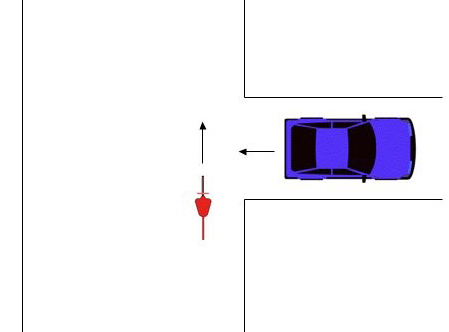
Situation:
A bicyclist is traveling near the curb and crosses a driveway. A motor vehicle backs up and doesn’t see the bicyclist.
Precautions:
Definitely don’t ride on the sidewalk since the motorist may not expect you and not see you. You need to approach a driveway just like you do a cross street. Assume that you may be invisible to the motorist. Move away from the curb and slow down. Keep you hands ready near the brake levers.
Door Ping
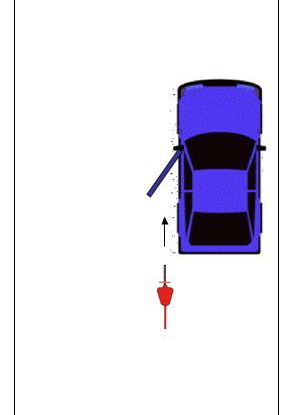
Situation:
A bicyclist travels down a road lined with parked cars. Someone opens a door and the bicycle hits the door, flies out into traffic, and gets hit by another motor vehicle.
Precautions:
Accident prevention for the “door ping” collision requires caution and anticipation. When you travel along a line of parked cars, stay at least 4 feet away from the cars and remember that each door could open with warning and quickly. You don’t want to swerve away from a door and into traffic. If you are already away from the cars, any oncoming motorist will know your path.
Big Squeeze
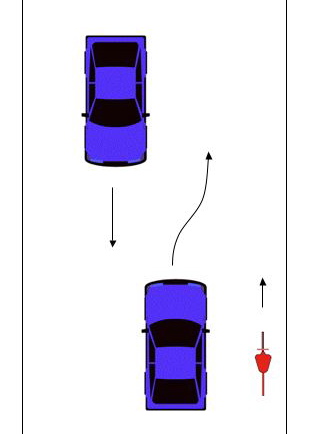
Situation:On a busy narrow road with two-way traffic, a bicyclist rides with the traffic. Two motor vehicles narrowly miss each other and one veers and hits the bicyclist.
Precautions:
The first precaution that you need to take is stay away from busy and narrow roads. If you have no alternate route, you should claim your position on the road, giving yourself enough pavement for bail out, and be ready to brake. Let the motor vehicles pass, but prepare for a bail out to rescue your day.
Can’t Be Seen
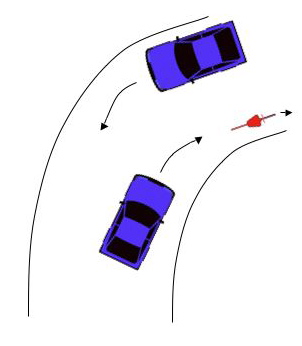
Situation:
On a narrow road that curves to form a blind spot, a motorist drives with the thought that nothing but another motor vehicle is before him. If driving in low light, fog, rain, or distracted for any reason, the motorist doesn’t see the bicyclist on the blind spot.
Precautions:
To prevent a car bicycle collision in this situation, you need to make yourself extremely visible. You might choose highly visible clothing, rear flashing light, and/or reflectors. If you are going around a sharp turn, you should move further out into the lane so that your presence will be known sooner. Just be prepared to move over for any on-coming motor vehicle after that have recognized you and begin to pass.
Can’t Be Seen
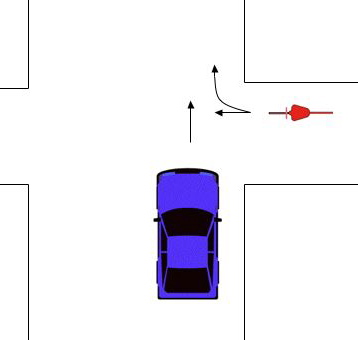
Situation:
A bicyclist leaves a driveway or small road and rides out into the crossing road. A motor vehicle doesn’t have time to react and hits the bike causing a bicycle car collision.
Precautions:
In this case, the cyclist is entirely responsible for bicycle accident prevention. Whenever you are leaving a driveway or similar exit, you need to slow down, stop if you can’t see the traffic, scan both directions, and proceed only when completely clear.
Trail Escape
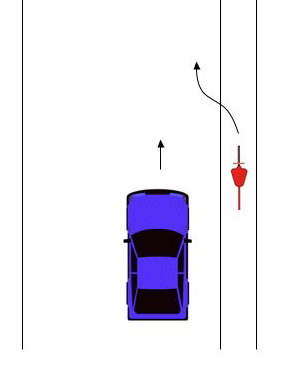
Situation:
A bicyclist rides along a bike trail that runs along a street. For some reason, the rider veers off the trail and into the street. The bicyclist surprises the motorist and gets hit. This bicycle car collision usually happens with young children.
Precautions:
The only reliable bicycle accident prevention for this situation is to educate your children to this danger or educate yourself. Don’t assume that the roadways are clear. Always verify traffic twice.
Trail Crossing
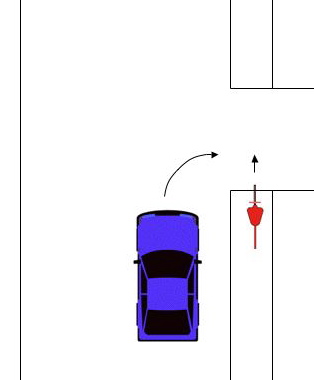
Situation:
A motorist making a turn into a bike trail crosswalk fails to see the bicyclist. The bicyclist is hit broadside.
Precautions:
You need to stay out of the motorist’s blind spot; make sure that you are in front or slightly ahead of the motor vehicle and look to your side and verify eye contact. Only enter the crosswalk after you are assured that no traffic is turning into the crosswalk. When you enter the crosswalk, slow down and keep your hands on the brake lever.
Deadly Left Turn 1
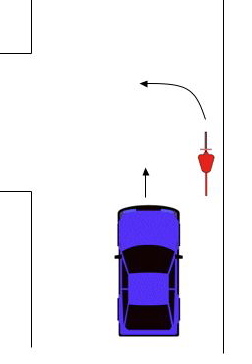
Situation:
A bicyclist rides along the curb in the proper lane and decides to make a turn across the traffic. A motor vehicle comes up from behind the cyclist and hits the bicyclist.
Precautions:
In this case, the cyclist is entirely responsible for bicycle accident prevention. It can be very dangerous to make a turn across traffic. For slow and light traffic, you need to blend in with the traffic and turn with the traffic when clear. For fast and heavy traffic, you should ride to an intersection and cross at the crosswalk either by riding or walking your bike. A bicycle car collision in this case is deadly for the cyclist.
Deadly Left Turn 2
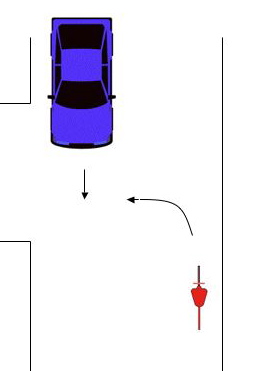
Situation:
A bicyclist rides along the curb in the proper lane and decides to make a turn across the traffic. A motor vehicle coming from the opposite direction and outer lane can’t stop in time and hits the bicyclist.
Precautions:
In this case, the cyclist is entirely responsible for bicycle accident prevention. It can be very dangerous to make a turn across traffic. On-coming traffic has the right-of-way for turning across traffic. For slow and light traffic, you need blend in with the traffic and turn with the traffic when clear. For fast and heavy traffic, you should ride to an intersection and cross at the crosswalk either by riding or walking your bike. A bicycle car collision in this case is deadly for the cyclist.
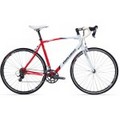
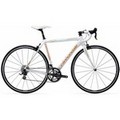
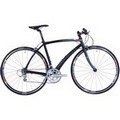

Just as important as accident prevention, having good preparation for accident response is prudent when you’re going on a tour that takes you away from urban areas. I’ve done 2 things to prepare: I bought a DeLorme inReach satellite communicator and have signed up for a Wilderness First Aid course given by the Wilderness Medicine Institute. The DeLorme inReach allows you to send and receive text messages to people you put on your contact list, or to any cell phone or email address, or send an “SOS” message to a call center which can dispatch emergency responders appropriate to your situation and location (medical evacuation by helicopter if necessary, or local ambulance, or just someone to bring you a spare wheel or pick you up and take you to a bike repair shop). You can interact by text dialog with the responders to let them know details so they can respond appropriately and give you medical advice while they’re in transit to you. It doesn’t use the cell phone network; rather it uses a satellite network, so it functions wherever you are in the world as long as you can get out in the open where the device can see the sky. The inReach also includes your location coordinates (latitude, longitude) and puts a link in the message to a mapping web page with a marker showing your location. Responders can locate you and so can your family and friends follow your trip on the tracking map. Very slick. The price is comparable or cheaper than a smart phone. Check out these ideas at http://www.inreachdelorme.com/ and http://www.nols.edu/wmi/ .